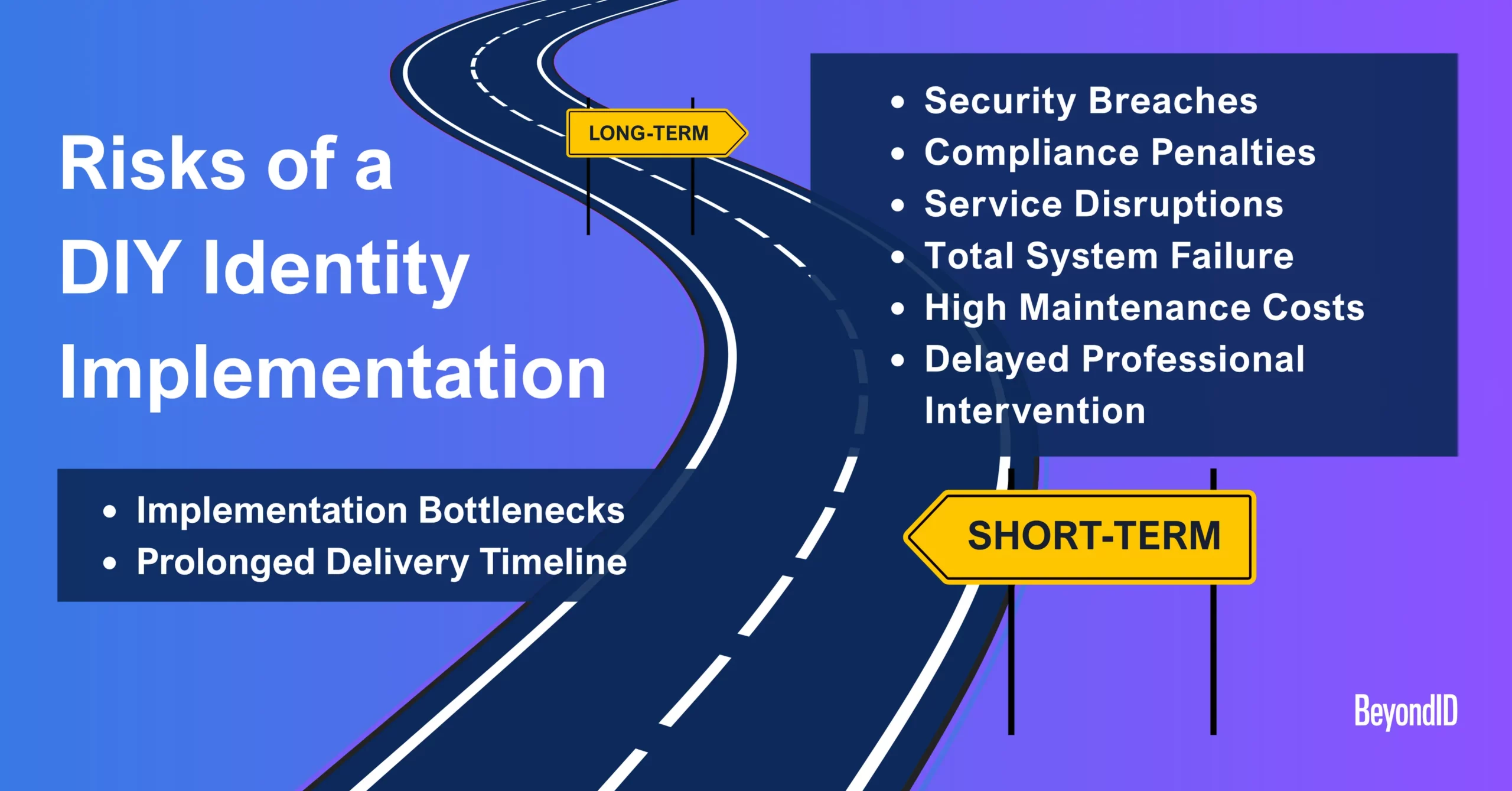Thinking about a DIY identity implementation for your organization? Sounds easy enough. Many IT teams start here—especially those who’ve successfully launched other cloud technologies. The appeal is obvious: more control, lower upfront costs, and the chance to use internal know-how.
But identity isn’t just another system—it’s the core of your enterprise’s security, compliance, and access management. When a DIY identity implementation goes wrong, the fallout can be far-reaching and costly.
This doesn’t mean you can’t be successful in your DIY journey; it just means that not every IT team has the right expertise to make a DIY implementation work. This blog breaks down what a DIY identity implementation involves, what to watch out for, and how to know if it’s the right fit for your team.
A DIY identity implementation refers to an organization choosing to build, configure, and manage its identity and access management (IAM) system in-house, rather than partnering with a managed services provider or using a fully managed identity platform.
DIY Success Starts with Knowing What Could Go Wrong
Identity implementations are anything but straight-forward. Take a look at some of the potential risks and hidden costs every organization should be aware of before kicking off a DIY identity implementation:

Without the right expertise, resources, and strategic planning, attempting to carry out digital transformations in-house can put your entire organization in jeopardy. This isn’t worst-case-scenario thinking — these are common challenges teams often face mid-project with a DIY identity implementation.
What Does Investing in an Identity Partner Really Get You?
| Accelerated Time to Value Proven methodologies and hands-on expertise help you stand up identity solutions faster—without cutting corners. | Specialized Expertise That Augments Your Team MISPs don’t replace your team—they strengthen it with identity specialists who fill critical knowledge gaps and elevate internal capabilities. |
| Strategic Guidance from Day One From roadmap development to long-term optimization, MISPs align your identity program with business goals—not just technical requirements. | Tailored Support That Scales with You Whether you need end-to-end implementation or just help with complex pieces, MISPs flex to meet your team’s needs and maturity level. |
| Reduced Risk and Rework Avoid costly DIY identity implementation missteps by designing your architecture right the first time—compliant, scalable, and secure from the start. | Seamless Integration Across Systems Expert configuration and integration with HR systems, EHR platforms, SaaS tools, and legacy infrastructure—no silos, no DIY identity implementation guesswork. |
| Continuous Optimization and Monitoring Post-implementation support includes performance monitoring, access reviews, threat detection, and compliance audits. | Improved Outcomes Across the Business Post-implementation support includes performance monitoring, access reviews, threat detection, and compliance audits. |
What About a Hybrid Approach to DIY Identity Implementation?
You don’t have to choose between a fully DIY identity implementation or handing everything off to a partner. With a hybrid identity implementation, teams do what they can in-house while bringing in expert help where they need it.
Here’s what that might look like:
- Partner-led discovery and architecture, with internal execution
- Internal DIY identity implementation reviewed by a partner before go-live
- A co-delivery model where your team and a Managed Identity Services Provider (MISP) share responsibilities
In BeyondID’s 2025 State of Cybersecurity Readiness report, 72% of IT professionals surveyed say they’re using some form of hybrid identity management.
That includes teams with limited external support (20%), those equally splitting responsibility with a partner (41%), and those relying more on external providers while maintaining internal oversight (11%). The takeaway? Hybrid isn’t one-size-fits-all—it’s a spectrum of involvement that gives teams the support they need, when they need it.
Let’s Compare
DIY Identity Implementation Hybrid Implementation Partner-Led Implementation Team Identity Expertise ✔️ Strong in-house identity and platform-specific skills make DIY identity implementation a natural fit ⚠️ Internal team has moderate identity experience; partner supplements key areas ❌ Limited identity expertise; need expert-led implementation Project Scope & Complexity ✔️ Best for DIY identity implementation when scope is narrow and integration points are limited ⚠️ Hybrid approach works well for mid-complexity identity projects ❌ Full partner support needed for complex, multi-platform deployments Internal Team Bandwidth ✔️ Teams with time and focus can succeed with DIY identity implementation ⚠️ Hybrid model balances internal ownership and partner assistance ❌ Stretched teams benefit from fully managed implementation Strategic Planning Needs ❌ DIY may lack strategic depth ✔️ Hybrid implementation includes partner-led architecture planning ✔️ Partner brings full identity strategy and roadmap planning Compliance & Audit Pressure ⚠️ DIY identity implementation works in low-pressure environments ✔️ Partner provides compliance guidance where needed ✔️ Partner ensures regulatory alignment from day one Technical Environment ✔️ DIY identity implementation fits flexible timelines ⚠️ Hybrid accelerates high-risk or time-sensitive phases ✔️ Partners drive faster implementations with dedicated resources Timeline Flexibility ✔️ DIY identity implementation fits flexible timelines ⚠️ Hybrid accelerates high-risk or time-sensitive phases ✔️ Partners drive faster implementations with dedicated resources Level of Control Desired ✔️ Full control and ownership with DIY identity implementation ✔️ Hybrid lets you retain control while accessing outside expertise ⚠️ Partner-led model requires trust in external team decisions Post-Go-Live Support Needs ❌ DIY identity implementation leaves ongoing support to internal teams ✔️ Hybrid offers long-term optimization and health checks ✔️ Partner provides continuous monitoring and support Budget Considerations ✔️ DIY is the most cost-effective upfront ✔️ Hybrid stretches your budget further by targeting partner use ❌ Partner-led is a higher investment but offers end-to-end delivery First-Time Accuracy ⚠️ DIY carries risk of errors without expert review ✔️ Hybrid includes expert validation to avoid rework ✔️ Partner ensures it’s built right from the start Scalability Goals ⚠️ DIY identity implementation may require later rework ✔️ Hybrid allows for scalable identity architecture with help ✔️ Partner builds a future-ready identity solution from the ground up
There’s no one-size-fits-all path to a successful identity implementation. Some teams have the internal expertise and capacity to manage a DIY identity implementation largely on their own. Others benefit from outside support—whether for strategic planning, complex integrations, or long-term scalability.
What’s most important is being clear-eyed about your goals, your resources, and the level of support needed to set your project up for lasting success. Whether you opt for a DIY identity implementation, partner-led implementation, or somewhere in between, the best approach is the one that aligns with your team’s strengths and your organization’s future.
Ready to start your digital identity transformation?
Let’s talk about which approach is right for your organization.










